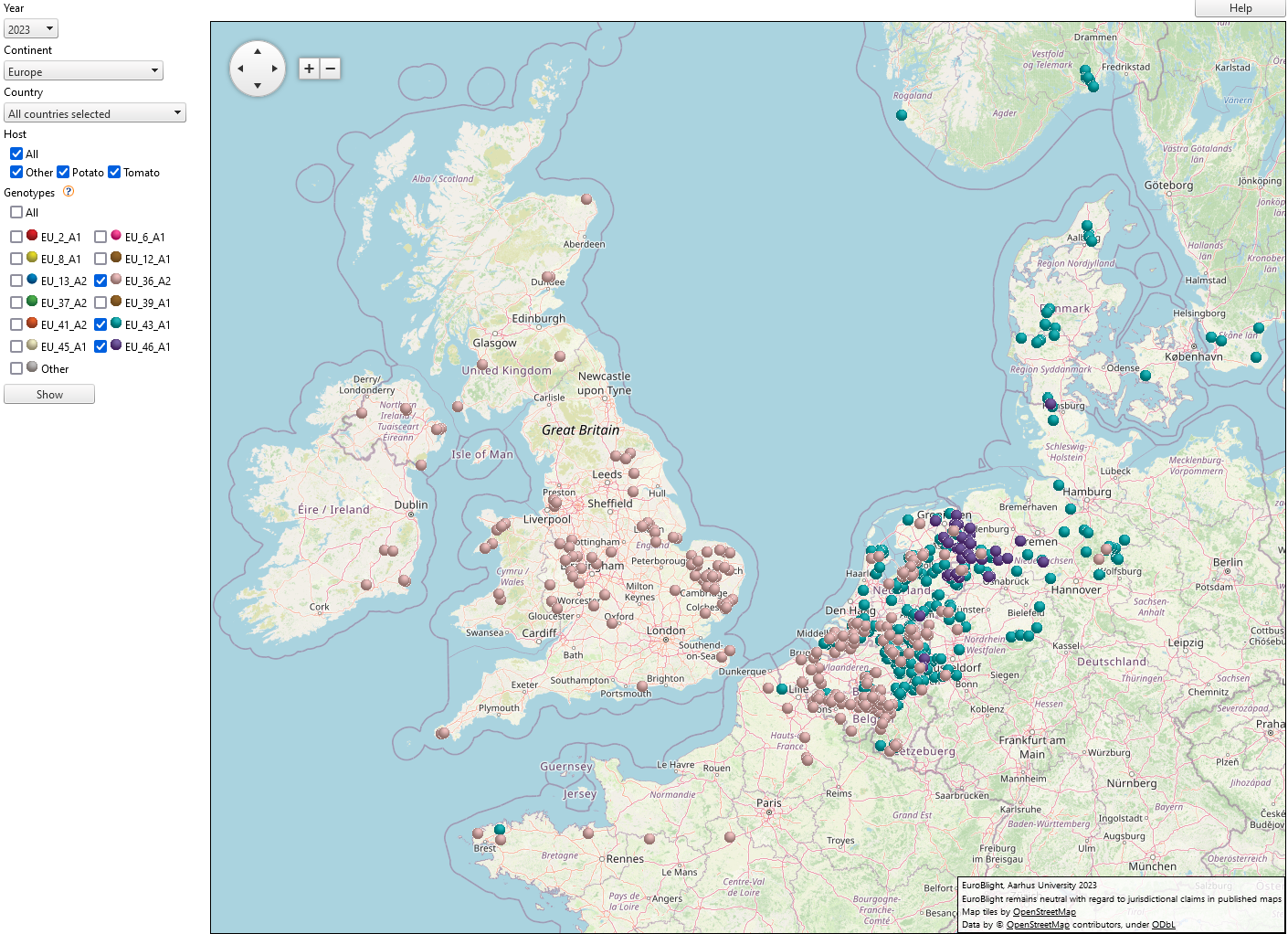EuroBlight early data release
EuroBlight released the first set of genotype results, 2023, early December,- now totalling 1916 results from all over Europe. More data to come

Given concerns at the impact of the EU43 lineage, the EuroBlight monitoring team were requested to release an early indication of the status of the 2023 population. This is well ahead of the customary date in the early spring of the following season. The majority of sponsors have been providing FTA card samples earlier than usual and the team at Hutton have been genotyping and reporting back on these samples throughout the season. It has been decided that there is now sufficient data uploaded to provide this update and the data was released to the public side of the database from the 8 December (four months earlier than last year's data).
The data release includes a large proportion of the anticipated dataset. It is important to note that EVERY group that provides samples is important. The EuroBlight concept relies on our collective effort to paint a detailed picture across the European population of P. infestans. Over the next weeks we continued to upload samples from all the groups. When we have analysed repeats of samples that failed on the first run we will complete a more detailed report and press release. A brief summary of the data to date:
-
EU43 is of concern given that a proportion of the population has proven resistant to the mandipropamid and other CAA fungicides. Although overall it comprised 25% of the 2023 samples to date it is locally higher; for example 55% (n = 467) in NL, 52% (n = 115) in DE and 36% (n = 250) in BE. Conversely, it fell from over 64% in 2022 to 24% (n = 113) this year in DK and was not reported at all in the UK. A single sample was however found in Ireland which may be a cause for concern and is under investigation.The scientific paper: "The EU43 genotype of Phytophthora infestans displays resistance to mandipropamid" was published in April2023
-
EU36 is an aggressive form of blight with no known issues with fungicide resistance but remains dominant across parts of Europe.
-
EU46 is a genotype related to EU43 and was reported in NL northwest DE and one isolate in the south of Denmark. More information will be released about this lineage in due course.
-
Genotyped samples n=1916 by 22 December, 2023
Genotype maps and charts are available here:
https://agro.au.dk/forskning/internationale-platforme/euroblight/pathogen-monitoring/genotype-map
We thank all the partners and sponsors that have (or will) contribute data this year. A full list will be provided in the later data release. We would also like to acknowledge Louise Sullivan and the rest of the team at Hutton who have worked hard to process the samples throughout the season, and AU for doing the data management and visualisation of the results.
Why is the frequency of EU43 decreasing in Denmark and increasing in other countries e.g. DE, NL and BE?
This question will be a key question at the forthcoming EuroBlight workshop in de Werelt, NL 13-16 May, 2024.
What we found in Denmark in 2023
-
The proportion of EU43 decreased from appr 64 % in 2022 to 24% in 2023.
-
EU43 found all through the season – evenly distributed
-
All EU43 tested in 2023 were resistant to mandipropamid but sensitive to oxathiapiprolin, cymoxanil and propamocarb
-
Results on sensitivity to fluazinam is inconclusive due to few isolates tested, but the tested isolates so far were all sensitive
Ongoing work
-
Many Euroblight research groups and industry partners are working to understand and add detail on the current situation in Europe and these findings will be shared at the EuroBlight workshop.
-
Several projects are ongoing such as “Proactive Fungicide Resistance Avoidance Strategies in potato – Potato FRAS” (2023-2026), a Danish National project. EuroBlight will facilitate the collaboration between projects
At the EuroBlight workshop we will have a dedicated session about fungicide resistance avoidance strategies related to emerging genotypes e.g. EU43 . Several partners will give presentations about the evolution and spread of EU43 and other clones. Lars Bødker, SEGES (extension) will explain how they in Denmark developed and communicated about a control strategy that were supposed to avoid a late blight epidemic as experienced in 2022 when EU43 took off. Finally in this session presentations from industry will share their experiences on the challenges of managing the new late blight lineages with recommendations for 2024.